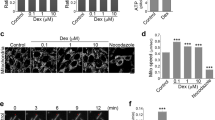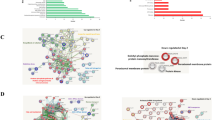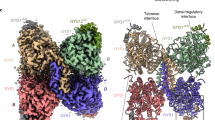Abstract
Accumulating evidence indicates that metabolic enzymes can directly couple metabolic signals to transcriptional adaptation and cell differentiation. Glycogen synthase 1 (GYS1), the key metabolic enzyme for glycogenesis, is a nucleocytoplasmic shuttling protein compartmentalized in the cytosol and nucleus. However, the spatiotemporal regulation and biological function of nuclear GYS1 (nGYS1) microcompartments remain unclear. Here, we show that GYS1 dynamically reorganizes into nuclear condensates under conditions of glycogen depletion or transcription inhibition. nGYS1 complexes with the transcription factor NONO/p54nrb and undergoes liquid–liquid phase separation to form biomolecular condensates, leading to its nuclear retention and inhibition of glycogen biosynthesis. Compared to their wild-type littermates, Nono-deficient mice exhibit exercise intolerance, higher muscle glycogen content, and smaller myofibers. Additionally, Gys1 or Nono deficiency prevents C2C12 differentiation and cardiotoxin-induced muscle regeneration in mice. Mechanistically, nGYS1 and NONO co-condense with the myogenic transcription factor MyoD and preinitiation complex (PIC) proteins to form transcriptional condensates, driving myogenic gene expression during myoblast differentiation. These results reveal the spatiotemporal regulation and subcellular function of nuclear GYS1 condensates in glycogenesis and myogenesis, providing mechanistic insights into glycogenoses and muscular dystrophy.
This is a preview of subscription content, access via your institution
Access options
Subscribe to this journal
Receive 12 print issues and online access
$259.00 per year
only $21.58 per issue
Buy this article
- Purchase on SpringerLink
- Instant access to full article PDF
Prices may be subject to local taxes which are calculated during checkout








Similar content being viewed by others
Data availability
All data necessary to evaluate the conclusions of this study are presented in the paper and/or the supplementary information. The mass spectrometry proteomics data have been deposited in the ProteomeXchange Consortium via the PRIDE partner repository, with dataset identifiers PXD051836 and PXD058561.
References
Roach PJ. Glycogen and its metabolism. Curr Mol Med. 2002;2:101–20.
Ferrer JC, Favre C, Gomis RR, Fernandez-Novell JM, Garcia-Rocha M, de la Iglesia N, et al. Control of glycogen deposition. Febs Lett. 2003;546:127–32.
Roach PJ, Depaoli-Roach AA, Hurley TD, Tagliabracci VS. Glycogen and its metabolism: some new developments and old themes. Biochem J. 2012;441:763–87.
Groop L, Orho-Melander M. New insights into impaired muscle glycogen synthesis. PLoS Med. 2008;5:e25.
Rybicka KK. Glycosomes-the organelles of glycogen metabolism. Tissue Cell. 1996;28:253–65.
Prats C, Graham TE, Shearer J. The dynamic life of the glycogen granule. J Biol Chem. 2018;293:7089–98.
Ferrer JC, Baque S, Guinovart JJ. Muscle glycogen synthase translocates from the cell nucleus to the cystosol in response to glucose. Febs Lett. 1997;415:249–52.
Cid E, Cifuentes D, Baque S, Ferrer JC, Guinovart JJ. Determinants of the nucleocytoplasmic shuttling of muscle glycogen synthase. FEBS J. 2005;272:3197–213.
Buschiazzo A, Ugalde JE, Guerin ME, Shepard W, Ugalde RA, Alzari PM. Crystal structure of glycogen synthase: homologous enzymes catalyze glycogen synthesis and degradation. EMBO J. 2004;23:3196–205.
Chang A, Singh S, Phillips GN Jr, Thorson JS. Glycosyltransferase structural biology and its role in the design of catalysts for glycosylation. Curr Opin Biotechnol. 2011;22:800–8.
Rao ST, Rossmann MG. Comparison of super-secondary structures in proteins. J Mol Biol. 1973;76:241–56.
Barbas A, Popescu A, Frazao C, Arraiano CM, Fialho AM. Rossmann-fold motifs can confer multiple functions to metabolic enzymes: RNA binding and ribonuclease activity of a UDP-glucose dehydrogenase. Biochem Biophys Res Commun. 2013;430:218–24.
Fuchs G, Diges C, Kohlstaedt LA, Wehner KA, Sarnow P. Proteomic analysis of ribosomes: translational control of mRNA populations by glycogen synthase GYS1. J Mol Biol. 2011;410:118–30.
Maldonado R, Mancilla H, Villarroel-Espindola F, Slebe F, Slebe JC, Mendez R, et al. Glycogen Synthase in Sertoli Cells: More Than Glycogenesis? J Cell Biochem. 2016;117:2597–607.
Narayanaswamy R, Levy M, Tsechansky M, Stovall GM, O’Connell JD, Mirrielees J, et al. Widespread reorganization of metabolic enzymes into reversible assemblies upon nutrient starvation. Proc Natl Acad Sci USA. 2009;106:10147–52.
O’Connell JD, Zhao A, Ellington AD, Marcotte EM. Dynamic reorganization of metabolic enzymes into intracellular bodies. Annu Rev Cell Dev Biol. 2012;28:89–111.
Prouteau M, Loewith R. Regulation of Cellular Metabolism through Phase Separation of Enzymes. Biomolecules. 2018;8:160.
Nesterov SV, Ilyinsky NS, Uversky VN. Liquid-liquid phase separation as a common organizing principle of intracellular space and biomembranes providing dynamic adaptive responses. Biochim Biophys Acta Mol Cell Res. 2021;1868:119102.
Jin M, Fuller GG, Han T, Yao Y, Alessi AF, Freeberg MA, et al. Glycolytic Enzymes Coalesce in G Bodies under Hypoxic Stress. Cell Rep. 2017;20:895–908.
Brangwynne CP. Phase transitions and size scaling of membrane-less organelles. J Cell Biol. 2013;203:875–81.
Banani SF, Lee HO, Hyman AA, Rosen MK. Biomolecular condensates: organizers of cellular biochemistry. Nat Rev Mol Cell Biol. 2017;18:285–98.
An S, Kumar R, Sheets ED, Benkovic SJ. Reversible compartmentalization of de novo purine biosynthetic complexes in living cells. Science. 2008;320:103–6.
Liu Q, Li J, Zhang W, Xiao C, Zhang S, Nian C, et al. Glycogen accumulation and phase separation drives liver tumor initiation. Cell. 2021;184:5559–5576 e5519.
Yang YS, Hanke JH, Carayannopoulos L, Craft CM, Capra JD, Tucker PW. NonO, a non-POU-domain-containing, octamer-binding protein, is the mammalian homolog of Drosophila nonAdiss. Mol Cell Biol. 1993;13:5593–603.
Knott GJ, Bond CS, Fox AH. The DBHS proteins SFPQ, NONO and PSPC1: a multipurpose molecular scaffold. Nucleic Acids Res. 2016;44:3989–4004.
Wei Y, Luo H, Yee PP, Zhang L, Liu Z, Zheng H, et al. Paraspeckle Protein NONO Promotes TAZ Phase Separation in the Nucleus to Drive the Oncogenic Transcriptional Program. Adv Sci. 2021;8:e2102653.
Zhang S, Cooper JA, Chong YS, Naveed A, Mayoh C, Jayatilleke N, et al. NONO enhances mRNA processing of super-enhancer-associated GATA2 and HAND2 genes in neuroblastoma. EMBO Rep. 2023;24:e54977.
Fan XJ, Wang YL, Zhao WW, Bai SM, Ma Y, Yin XK, et al. NONO phase separation enhances DNA damage repair by accelerating nuclear EGFR-induced DNA-PK activation. Am J Cancer Res. 2021;11:2838–52.
Benegiamo G, Mure LS, Erikson G, Le HD, Moriggi E, Brown SA, et al. The RNA-Binding Protein NONO Coordinates Hepatic Adaptation to Feeding. Cell Metab. 2018;27:404–418.e407.
Fox AH, Lam YW, Leung AK, Lyon CE, Andersen J, Mann M, et al. Paraspeckles: a novel nuclear domain. Curr Biol. 2002;12:13–25.
Fox AH, Nakagawa S, Hirose T, Bond CS. Paraspeckles: Where Long Noncoding RNA Meets Phase Separation. Trends Biochem Sci. 2018;43:124–35.
Li S, Li Z, Shu FJ, Xiong H, Phillips AC, Dynan WS. Double-strand break repair deficiency in NONO knockout murine embryonic fibroblasts and compensation by spontaneous upregulation of the PSPC1 paralog. Nucleic Acids Res. 2014;42:9771–80.
Charge SB, Rudnicki MA. Cellular and molecular regulation of muscle regeneration. Physiol Rev. 2004;84:209–38.
Wosczyna MN, Rando TA. A Muscle Stem Cell Support Group: Coordinated Cellular Responses in Muscle Regeneration. Dev Cell. 2018;46:135–43.
Asfour HA, Allouh MZ, Said RS. Myogenic regulatory factors: The orchestrators of myogenesis after 30 years of discovery. Exp Biol Med (Maywood). 2018;243:118–28.
Wardle FC. Master control: transcriptional regulation of mammalian Myod. J Muscle Res Cell Motil. 2019;40:211–26.
Wang R, Chen F, Chen Q, Wan X, Shi M, Chen AK, et al. MyoD is a 3D genome structure organizer for muscle cell identity. Nat Commun. 2022;13:205.
Chong S, Dugast-Darzacq C, Liu Z, Dong P, Dailey GM, Cattoglio C, et al. Imaging dynamic and selective low-complexity domain interactions that control gene transcription. Science. 2018;361:eaar2555.
Plys AJ, Kingston RE. Dynamic condensates activate transcription. Science. 2018;361:329–30.
Hnisz D, Shrinivas K, Young RA, Chakraborty AK, Sharp PA. A Phase Separation Model for Transcriptional Control. Cell. 2017;169:13–23.
Shav-Tal Y, Blechman J, Darzacq X, Montagna C, Dye BT, Patton JG, et al. Dynamic sorting of nuclear components into distinct nucleolar caps during transcriptional inhibition. Mol Biol Cell. 2005;16:2395–413.
Diaz A, Martinez-Pons C, Fita I, Ferrer JC, Guinovart JJ. Processivity and Subcellular Localization of Glycogen Synthase Depend on a Non-catalytic High Affinity Glycogen-binding Site. J Biol Chem. 2011;286:18505–14.
Cid E, Gomis RR, Geremia RA, Guinovart JJ, Ferrer JC. Identification of two essential glutamic acid residues in glycogen synthase. J Biol Chem. 2000;275:33614–21.
Wilson WA, Boyer MP, Davis KD, Burke M, Roach PJ. The subcellular localization of yeast glycogen synthase is dependent upon glycogen content. Can J Microbiol. 2010;56:408–20.
Branon TC, Bosch JA, Sanchez AD, Udeshi ND, Svinkina T, Carr SA, et al. Efficient proximity labeling in living cells and organisms with TurboID. Nat Biotechnol. 2018;36:880-7.
Bellucci M, Agostini F, Masin M, Tartaglia GG. Predicting protein associations with long noncoding RNAs. Nat Methods. 2011;8:444–5.
Chen B, Deng S, Ge T, Ye M, Yu J, Lin S, et al. Live cell imaging and proteomic profiling of endogenous NEAT1 lncRNA by CRISPR/Cas9-mediated knock-in. Protein Cell. 2020;11:641–60.
Hermansen L, Hultman E, Saltin B. Muscle glycogen during prolonged severe exercise. Acta Physiol Scand. 1967;71:129–39.
Testoni G, Duran J, Garcia-Rocha M, Vilaplana F, Serrano AL, Sebastian D, et al. Lack of Glycogenin Causes Glycogen Accumulation and Muscle Function Impairment. Cell Metab. 2017;26:256–266.e254.
Hardenberg M, Horvath A, Ambrus V, Fuxreiter M, Vendruscolo M. Widespread occurrence of the droplet state of proteins in the human proteome. Proc Natl Acad Sci USA. 2020;117:33254–62.
Fastman NM, Liu Y, Ramanan V, Merritt H, Ambing E, DePaoli-Roach AA, et al. The structural mechanism of human glycogen synthesis by the GYS1-GYG1 complex. Cell Rep. 2022;40:111041.
McCorvie TJ, Loria PM, Tu M, Han S, Shrestha L, Froese DS, et al. Molecular basis for the regulation of human glycogen synthase by phosphorylation and glucose-6-phosphate. Nat Struct Mol Biol. 2022;29:628–38.
Kollberg G, Tulinius M, Gilljam T, Ostman-Smith I, Forsander G, Jotorp P, et al. Cardiomyopathy and exercise intolerance in muscle glycogen storage disease 0. N Engl J Med. 2007;357:1507–14.
Pederson B, Chen HY, Schroeder J, Shou WN, Depaoli-Roach A, Roach P. Effect of muscle glycogen synthase (GYS1) knockout on cardiac development and glucose homeostasis. Diabetes. 2003;52:A301–A302.
Xu X, Jiang H, Lu Y, Zhang M, Cheng C, Xue F, et al. Deficiency of NONO is associated with impaired cardiac function and fibrosis in mice. J Mol Cell Cardiol. 2019;137:46–58.
Sunwoo H, Dinger ME, Wilusz JE, Amaral PP, Mattick JS, Spector DL. MEN epsilon/beta nuclear-retained non-coding RNAs are up-regulated upon muscle differentiation and are essential components of paraspeckles. Genome Res. 2009;19:347–59.
Lee C, Quintana A, Suppanz I, Gomez-Auli A, Mittler G, Cisse, II Light-induced targeting enables proteomics on endogenous condensates. Cell. 2024;187:7079–7090.e17.
Pei G, Lyons H, Li P, Sabari BR. Transcription regulation by biomolecular condensates. Nat Rev Mol Cell Biol. 2024;26:213–36.
Piekarowicz K, Bertrand AT, Azibani F, Beuvin M, Julien L, Machowska M, et al. A Muscle Hybrid Promoter as a Novel Tool for Gene Therapy. Mol Ther Methods Clin Dev. 2019;15:157–69.
Preiss T, Hall AG, Lightowlers RN. Identification of bovine glutamate dehydrogenase as an RNA-binding protein. J Biol Chem. 1993;268:24523–6.
Nagy E, Henics T, Eckert M, Miseta A, Lightowlers RN, Kellermayer M. Identification of the NAD(+)-binding fold of glyceraldehyde-3-phosphate dehydrogenase as a novel RNA-binding domain. Biochem Biophys Res Commun. 2000;275:253–60.
Anderson SL, Schirf V, McAlister-Henn L. Effect of AMP on mRNA binding by yeast NAD+-specific isocitrate dehydrogenase. Biochemistry. 2002;41:7065–73.
Pioli PA, Hamilton BJ, Connolly JE, Brewer G, Rigby WF. Lactate dehydrogenase is an AU-rich element-binding protein that directly interacts with AUF1. J Biol Chem. 2002;277:35738–45.
Sun FJ, Caetano-Anolles G. The ancient history of the structure of ribonuclease P and the early origins of Archaea. BMC Bioinformatics. 2010;11:153.
Brewer MK, Torres P, Ayala V, Portero-Otin M, Pamplona R, Andres-Benito P, et al. Glycogen accumulation modulates life span in a mouse model of amyotrophic lateral sclerosis. J Neurochem. 2023;168:744–59.
Li C, Wei Q, Gu X, Chen Y, Chen X, Cao B, et al. Decreased Glycogenolysis by miR-338-3p Promotes Regional Glycogen Accumulation Within the Spinal Cord of Amyotrophic Lateral Sclerosis Mice. Front Mol Neurosci. 2019;12:114.
Homma S, Beermann ML, Yu B, Boyce FM, Miller JB. Nuclear bodies reorganize during myogenesis in vitro and are differentially disrupted by expression of FSHD-associated DUX4. Skelet Muscle. 2016;6:42.
Xiao L, Yin Y, Sun Z, Liu J, Jia Y, Yang L, et al. AMPK phosphorylation of FNIP1 (S220) controls mitochondrial function and muscle fuel utilization during exercise. Sci Adv. 2024;10:eadj2752.
Xie X, Hu H, Tong X, Li L, Liu X, Chen M, et al. The mTOR-S6K pathway links growth signalling to DNA damage response by targeting RNF168. Nat Cell Biol. 2018;20:320–31.
Alberti S, Saha S, Woodruff JB, Franzmann TM, Wang J, Hyman AA. A User’s Guide for Phase Separation Assays with Purified Proteins. J Mol Biol. 2018;430:4806–20.
Patil A, Strom AR, Paulo JA, Collings CK, Ruff KM, Shinn MK, et al. A disordered region controls cBAF activity via condensation and partner recruitment. Cell. 2023;186:4936–4955.e4926.
Acknowledgements
We thank the Core Facilities at the State Key Laboratory of Oncology in South China and the Medical Science Public Platform of Shenzhen Campus, Sun Yat-sen University, for their assistance with imaging experiments. The mScarlet-labeled MS2-tagged Neat1_2 knock-in cell line was provided by Professor Zhou Songyang from Sun Yat-sen University. The GYS2 and SC35 cDNAs were provided by Professor Ronggui Hu at the Shanghai Institute of Biochemistry and Cell Biology, while the AAV vectors were provided by Professor Qiurong Ding from the Shanghai Institute of Nutrition and Health.
Funding
This project is supported by the National Natural Science Foundation of China (No. 31871439 to XX, No. 32425019 to ZG), Ministry of Science and Technology of China (National Key R&D Program of China 2022YFA0806000) to ZG, the Shenzhen Science and Technology Program (JCYJ20240813151133043 and JCYJ20220530145613030 to XX), the Guangdong Basic and Applied Basic Research Foundation (2023A1515011923 to XX), and the Open Funds from the State Key Laboratory of Oncology in South China (HN2022-02 to XX and LF).
Author information
Authors and Affiliations
Contributions
X Xie conceived the idea; S Peng, C Li, Y Wang, Y Yi, X Chen, Y Yin, Z Gan, and X Xie designed and performed the experiments, with contributions from F Yang, F Chen, Y Ouyang, H Xu, B Chen, H Shi, Y Zhao, and L Feng; Q Li performed TurboID MS analysis. S Peng, C Li, Y Wang, Y Yi, Z Gan, and X Xie analyzed the data and wrote the manuscript with input from all other authors. L Feng, Z Gan, and X Xie supervised the project.
Corresponding authors
Ethics declarations
Competing interests
The authors declare no competing interests.
Additional information
Publisher’s note Springer Nature remains neutral with regard to jurisdictional claims in published maps and institutional affiliations.
Rights and permissions
Springer Nature or its licensor (e.g. a society or other partner) holds exclusive rights to this article under a publishing agreement with the author(s) or other rightsholder(s); author self-archiving of the accepted manuscript version of this article is solely governed by the terms of such publishing agreement and applicable law.
About this article
Cite this article
Peng, S., Li, C., Wang, Y. et al. The metabolic enzyme GYS1 condenses with NONO/p54nrb in the nucleus and spatiotemporally regulates glycogenesis and myogenic differentiation. Cell Death Differ (2025). https://doi.org/10.1038/s41418-025-01509-4
Received:
Revised:
Accepted:
Published:
DOI: https://doi.org/10.1038/s41418-025-01509-4



